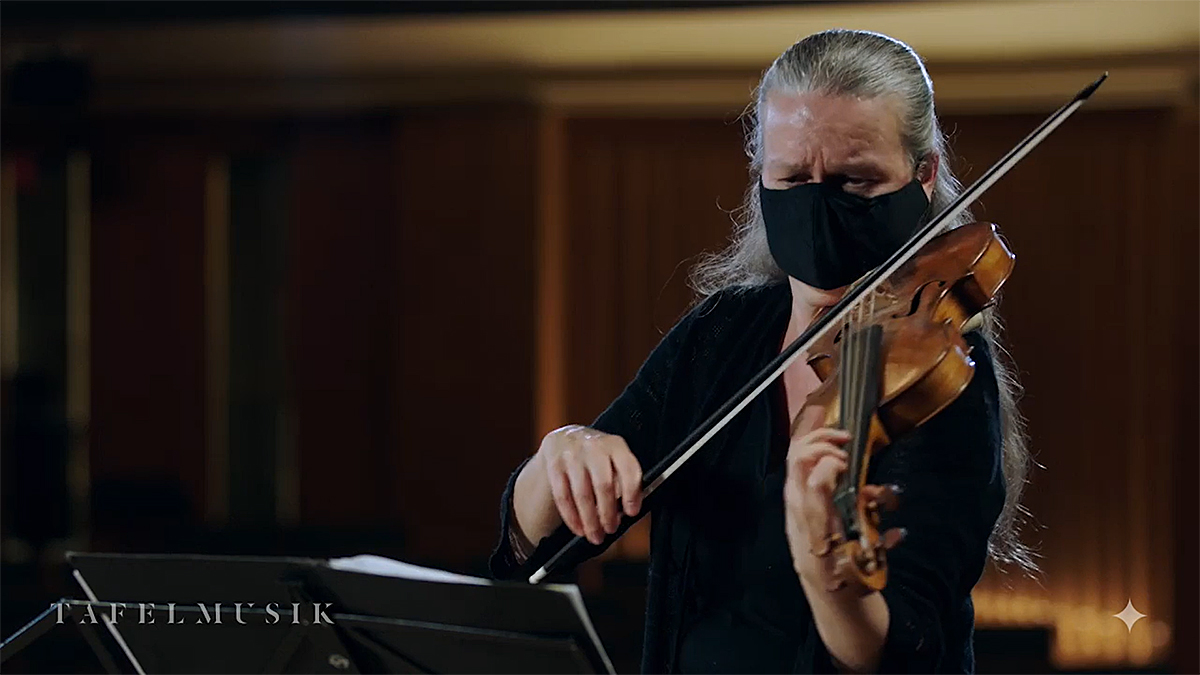Violinist Geneviève Gilardeau
Tafelmusik violinist Geneviève Gilardeau talks alternate tunings and shares insight as the program curator ahead of our upcoming chamber concert, Close Encounters: Re-Tuned.
Tafelmusik: How common are alternate tunings in baroque music repertoire?
Geneviève Gilardeau: There are more pieces in all kinds of different tunings than we are usually aware of, but we typically don’t explore them during a concert for practical reasons. Going from one tuning to another during a concert needs to be planned carefully: the instrument can take from a few minutes to a few hours to acclimate to a new tuning. Without that time, you might end up with a very out of tune instrument in the middle of a piece. So, very often, we simply bypass pieces that are not in standard tuning. For Re-Tuned, as I was puzzling through how to make a program that accommodated the tuning of the Erlebach trio sonata that I was dreaming of playing, I decided to explore other works in the same tuning and avoid having to go into standard tuning at all.
TM: For Close Encounters: Re-Tuned, you are using one of the more popular re-tunings, AEAE. How does this tuning sound different, to an audience’s ear?
GG: The AEAE tuning makes the instrument sound more open because it resonates sympathetically with itself. It has been called open-tuning for this reason.
TM: For Re-Tuned, are all of the instruments—the violins, viola da gamba, cello, and lute—using alternate tunings? Or just select instruments?
GG: In Re-Tuned, the violins are tuned AEAE and the lute, the gamba, and the cello are tuned in their standard tuning—except for the wonderful small set of pieces that Lucas is offering. These pieces are in exploratory tunings for the lute.
TM: When Tafelmusik tunes their instruments, do you use a tuner, or do you do so by ear?
GG: In Tafelmusik, we usually tune from the harpsichord, and the concertmaster passes the notes on to each section of the orchestra. But the starting point is a tuning fork or a tuner.
TM: What piece, or pieces, from this upcoming program are you most excited for audiences to hear?
GG: I got to choose all the pieces of this program, so I am excited to present them all. But the starting point was a trio sonata by Erlebach that I fell in love with.
Erlebach's music was almost all lost in a fire, about fifty years after his death. I used to listen to a recording of Erlebach trio sonatas with my daughter when she was very little to help her slow down at night. I used to feel an incredible warmth in the darkened room when this particular piece came on. (I found out recently that Erlebach has the same birthday as my daughter, only 350 some years earlier!)
When I discovered that one of the common tunings amongst fiddlers was the same as the tuning of my favorite Erlebach trio sonata, I got very excited. At first, I looked at finding a mentor in town to explore some fiddle pieces, but finding the time was almost impossible. And then, the pandemic started, and musicians from all around the world became available for online teaching. I had the privilege, in the last few months, to work with some wonderful fiddlers: David Greenberg (who was a core member of Tafelmusik many years ago), Shane Lestideau in Australia, and Alasdair Fraser. The AEAE tuning took me on a really inspiring journey, and I can't wait to share it with everyone this Thursday, November 12 at Re-Tuned.
TM: In this program, you will be performing fiddle music. Is there crossover between baroque stylings and fiddle stylings?
GG: Many composers visited Scotland in the 18th century, and included Scottish melodies and rhythms in their own works. Eighteenth century Scotland was a meeting point between composed written music and traditional music. Many national traditional styles, including the traditional music of my native Quebec, have been influenced by its music.
Traditional fiddle music and baroque music also have in common their connection to dance and their strong component of improvised ornamentation. To our modern ears, there is also a difference that is common to both fiddle music and baroque music and it has to do with the use of vibrato. The vibrato is used as an ornament and is not part of the core sound.
Our upcoming program, Close Encounters: Re-Tuned, takes place on November 12, 2020, 8pm EST. Learn more and buy tickets here.

